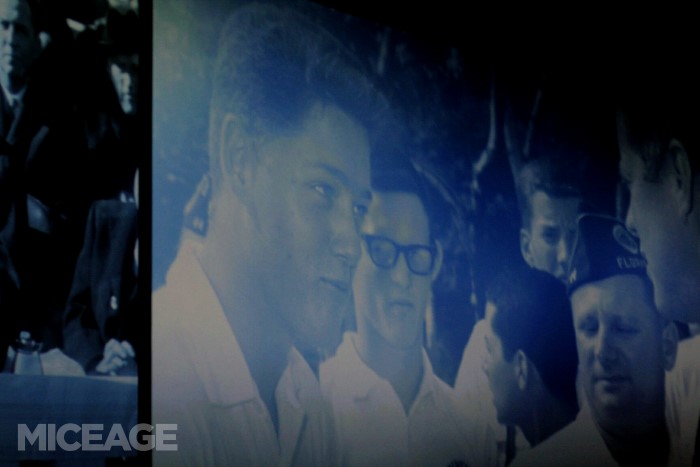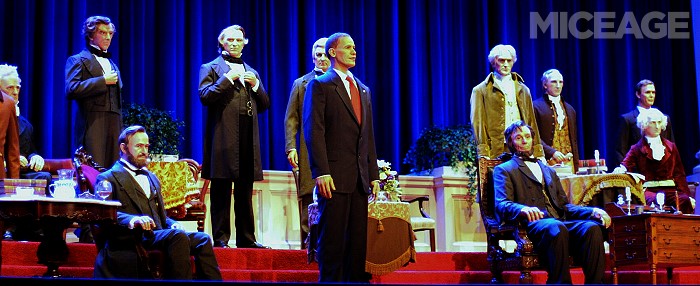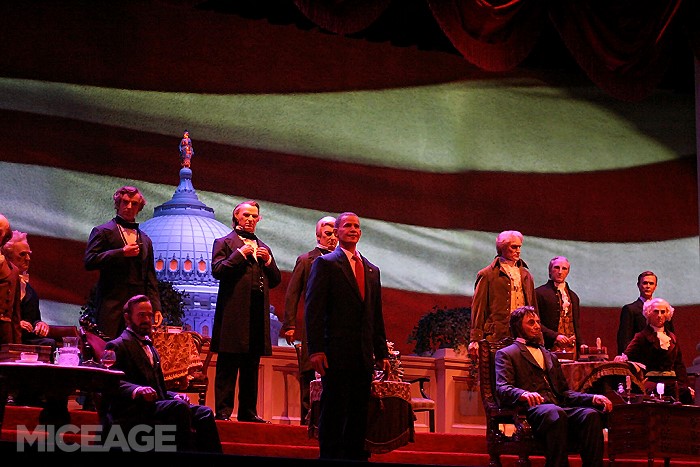|
This past weekend, Walt Disney World's Magic Kingdom offered a sneak peek of
a revamped Hall of Presidents, now including President Obama, to annual
passholders (with separate screenings for Cast Members). By the end of the
day Sunday, regular guests were admitted to the attraction as well, and
full-blown soft opening appears underway. The attraction opens publicly on
July 4th.
The verdict by most reviewers online and in discussion boards has been
positive, and in some cases glowingly positive. Yet this is a difficult
attraction to review completely and in a way that will appear objective to
all readers, because as I see it, Walt Disney Imagineering (WDI) seems to
have done something new here: on the surface of things, they appear to have
taken sides politically. I've already witnessed first-hand that this makes
some people react less than favorably to the show. It probably won't be the
majority of people who dislike it, but the days of the attraction being seen
as a fully neutral presentation are gone, at least for now.
|
|
 |
The attraction sports new marquees, a new countdown clock indicating how
many minutes until the next show, and a new subtitle: "A Celebration of
Liberty's Leaders." There are new movies (well, slideshow presentations),
and they are displayed in eye-popping, unrealistically bright and cheerful
projections, the result of a switch to digital projectors. It's jarring, in
fact, how "fresh" that part of the show looks when compared to your memory
of the dingy, cracked, faded, and often dirty film print that used to run
here.
But this is no mere freshening of the same show, with the new president
plopped into place at the end. This was a fundamental rethink of the show's
purpose, scope, and orientation. The bottom line is that the show now offers
park visitors an actual, honest to goodness thesis: everything in American
presidential history, it claims by virtue of a new storyline, has been
inexorably leading up to this moment, and the election of Barack Obama is
the culmination of a long "development" in us as a culture and a society.
There will be many who cheer this line of reasoning, but it strikes me that
others may resent the apparent taking of sides. Had John McCain won the
election, would the show celebrate in a similar way?

The lobby is mostly
unchanged, though the new title is visible here,
and a new display case shows outfits worn by several First Ladies.
Of course, Obama's presidency is historic in a way that McCain's would
not have been, if for no other reason than Obama's multiracial background.
His victory reflects a major change from the past, and the revamped show
would want to acknowledge that. It would be hard to have any objections on
these grounds.
But no matter how you personally voted in the 2008 election, we all
recognize that some folks voted for candidates who didn't win, and those
folks are arguably being excluded in the celebration promoted by the new
show, since the show is not as neutral as its previous versions had been.
That's the problem with developing a "story" out of the list of presidents
over time; such a narrative by definition creates the impression that Obama
was supposed to win…and furthermore implies that anyone else was
supposed to lose in that election. I think this will alienate some folks.
Let's back up to the start of the show and take it from there. We begin
with the familiar preamble to the Declaration of Independence, and quickly
turn to the early story in Philadelphia. Our new (disembodied) narrator is
actor Morgan Freeman, with a comforting and familiar voice that has the
suitable gravitas the role calls for. The narration points out that America
was going to be different from the beginning because it would not be a
monarchy; we would dare to choose our own leader. And our first leader,
George Washington, would further solidify our national character by opting
to step down after two terms. The man who could be king, Freeman notes, was
really just "one of us" and only wanted the title of citizen of the United
States.

Washington is shown
returning to his family after serving the nation.
If there's an obvious theme to the slideshow, "one of us" would be a
reasonable choice. The phrase itself is repeated several times in the
narration, and the remainder of the slideshow unfolds with cherry-picked
history designed to imply that the country moved forward only when a humble
commoner was in command. Only some presidents even warrant a mention, with
others left entirely unmentioned.
Andrew Jackson comes after Washington, and he is lauded for being
non-aristocratic by birth, and allowing the unwashed masses admission to the
executive mansion after his election, much to the dismay of Washington
insiders.
From there, we fast-forward to Abraham Lincoln and the looming Civil War,
for which the presentation goes to a wide-screen format, using even more of
the Circle-Vision screens. Some of the audio here is recycled from the
previous show. Lincoln is also shown as a common man, for he was
self-taught, and unassuming. But his beliefs in the equality of men stand
above his other traits.
The Civil War section of the slideshow concludes with the screens
separating from each other to create a pocket of space on the stage, and a
few curtains rise to reveal Lincoln himself, seated. There are other
curtains all around him, and the curved curtain immediately behind him will
show the sharp-eyed visitor what's to come: other presidents are lurking
just behind the curtains, but for now, we are only treated to Lincoln, and a
special curtain crafts a bubble of space to make this "private performance"
possible.

Lincoln has always moved
gracefully and realistically.
Lincoln delivers the elegantly concise Gettysburg Address in its
entirety. The screens had been showing the site of the battle of Gettysburg,
so it's logical for Lincoln to deliver this one speech rather than a
collection of speeches pasted together as was done for his World's Fair
debut.
After his speech, the screens recombine for more slideshow images. We see
a few drawings (airplane, transcontinental railroad) that snap into still
photographs with the sudden pop of a flashbulb, neatly transitioning the
slideshow from the age of paintings (which it had used exclusively until
now) to the age of photographs (which it will use exclusively from here on
out).
Up next is Teddy Roosevelt, who is celebrated for his unique combination
of tough-guy credentials and soft-spoken approachability. It is Teddy, we
learn, who was humble and populist enough to consider the executive mansion
to be just a house… a white house, and proclaimed that that would be its
simple name ever after.
The presentation switches to Franklin Delano Roosevelt, and the slideshow
highlights first that FDR was a mortal, even fragile, human himself,
crippled as he was by polio. Then, we are told repeatedly that FDR created
hope out of despair, and his calm voice reassured the worried masses.
We skip to John F. Kennedy next, and the parts of his speeches that are
played make evident that the torch is being passed to a younger generation,
and that the world is being changed in radical and fundamental ways. (If you
look at the right-hand screen at this point, you'll see a
young Rhodes Scholar Bill Clinton meeting JFK).

A young Bill Clinton.
There is no direct discussion of the remaining presidents, but several
are given a chance to speak with no voiceover by the narrator. Morgan
Freeman sets up the sequence by intoning that presidents are at their best
when they convey what's already in the hearts of the populace, especially
during times of tragedy. LBJ mourns the slain Kennedy, Reagan eulogizes the
Challenger disaster victims, Clinton consoles Oklahoma City, and George W.
Bush takes the bullhorn at Ground Zero to exclaim "We can hear you, the
world can hear you." Bush's quote originally continued with "and the people
who knocked these buildings down will hear all of us soon," but this was cut
and replaced instead with a crowd chanting "USA" over and over again.
The inclusion of Reagan and Bush provides a bit of counterbalance; it's
not like the show displays only presidents from the liberal end of the
political spectrum. But the highlighting of only some presidential profiles
does reveal a preference for distinct change. Look again at the list of
biographies and the qualities associated with each person:
| Washington (humble) |
Teddy (populism) |
| Jackson (of common birth) |
FDR (provides hope and reassurance) |
| Lincoln (stresses equality) |
JFK (pass the torch and
change the world) |
It's surely no accident that these are many of the attributes often cited
in Obama's presidency by the media. It would be quite hard to imagine this
very slideshow used to introduce President John McCain, but it's easy to see
it as an introduction for Obama. Indeed, the argument is all but said out
loud that the history of the American presidency has been leading us up to
this point, and that Obama's election was inevitable.
The show then opens up to the stage, as the curtain rises and the
assemblage of presidents becomes visible. The screens, as they separate,
display a launching Space Shuttle as they make room for the stage, and we
hear an uncredited Ronald Reagan giving part of his speech about the
Challenger: "Nothing ends here; our hopes and our journeys continue."

The presidents are
scattered around on both sides of the stage.
As in past presentations, the narrator makes a roll call of the
presidents, with a spotlight briefly illuminating each one, who nods at the
audience when his name is called. After George W. Bush, though, Obama's name
does not immediately follow. Instead, the George Washington animatronic
stands up and delivers a brief speech, explaining to his audience that he
only had the confidence to take office because he took an oath, just
thirty-five simple words that have been repeated by every president ever
since.

The first president
introduces the current one.
This provides the cue for Obama, and he recites the oath of office. Then,
the narrator presents him to us formally, and he delivers a brief speech:
The American dream is as old as our family, but as timeless as our
hopes. It is reborn every day in the heart of every child who wakes up
in a land of limitless possibilities, in a country where "we the people"
means ALL the people. We may come from different places and believe
different things, but what makes us American is a shared spirit: a
spirit of courage and determination, of kindness and generosity. It is a
spirit grounded in the wisdom of the generations that have gone before
us, open to the unimagined discoveries and possibilities on the horizon
that lies ahead. Let us enjoy it, cherish it, defend it, and pass it on
to our children as the bright and beautiful blessing it is: this
enduring American dream.

It's soon to be "dawn in
America," or something like that.
As he speaks, the starscape behind Obama is replaced by a rosy dawn, and
then a waving flag projection. This is a much more active projected image
than the sedate "flag in the sky" cloud formation seen in past versions of
the show.
Meanwhile, the swelling music crescendos into the last two lines of
America the Beautiful:
America! America!
God shed His grace on thee,
And crown thy good with brotherhood,
from sea to shining sea!
With that, the curtains close, and the twenty minute show comes to an
end. As I see it, it's no accident that the last line is one of
"brotherhood" and implied belongingness. For indeed, the show's theme ("one
of us") is repeated throughout. The more one thinks about the theme, the
more it makes sense.

It's technologically
impressive, but emotionally underwhelming.
Sure, it's pretty easy to see the surface meaning: Obama is "one of us,"
with "us" being the everyday people in America, rather than part of the rich
elite. He came from a working-class background.
For African-Americans in the audience, the phrase has a second meaning in
that this presidency marks the first time they can say that the new
president is "one of us."
But this simple phrase has even more permutations. It could even be
viewed from the perspective of the presidents themselves, as if they are
reassuring the audience that the newest president is just like them; he is
"one of us" now and part of the presidential brotherhood.
If all that sounds overly cerebral, it's probably intentional and yet
another way the show is honoring the newest president--because, after all,
being cerebral is another attribute often associated with Obama.
It would be fairly simple to extend the "cerebral" argument right down to
the very tone of the new show. Using the simplified rhetoric of Aristotle's
appeals, one could say that the old show banked on ethos (the character of
the speakers) and pathos (emotion, in the form of stirring patriotic music).
But while the old show used "Battle Hymn of the Republic" to inspire and
whip up nationalism almost to a frenzy, the new show only briefly introduces
music, and to my ears the bit of "America the Beautiful" that we hear is not
nearly as inspiring a song. It simply doesn't soar at the end, so
the last ten seconds of the show feel somehow flat and anticlimactic.

Obama the intellectual.
In fact, one could almost argue that the "pathos" of the show has been
replaced by Aristotle's last appeal, logos (logic). That brings us back to
"cerebral" and intellectual, and here the attraction's storyline seems to
back up this interpretation. In offering a thesis about the inevitability of
Obama's presidency (academics would call this a "teleological" approach),
the show functions in the end analysis as a well-constructed, logical
argument (rather than an emotional one).
It was a bold, and maybe even daring, move for the Imagineers to head in
this direction, since the attraction could be considered more neutral until
now. But you may find as I did that the longer you dwell on the nature of
the changes -- the more likely you are to see them as not only
well-intentioned, but also well-positioned.
Simply adding Obama to the presentation might be politically safer, but
the designers opted to freshen the show, and the only way to inject vitality
and newness into the presentation is to, well, CHANGE it. "Change" was the
tentpole of Obama's platform, and he did win the election, so it's hardly
revolutionary to adopt his position in the new attraction. After all,
history, as they say, is always written by the victors. |
